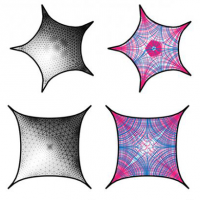Tag: 2-5d-surfaces
-
 Principal stress line computation for discrete topology designKam-Ming Mark Tam, MIT MEng Thesis, 2015
Principal stress line computation for discrete topology designKam-Ming Mark Tam, MIT MEng Thesis, 2015Principal stress lines, which are pairs of orthogonal curves that indicate trajectories of internal forces and therefore idealized paths of material continuity, naturally encode the optimal topology for any structure for a given set of boundary conditions. Although stress line analysis has the potential to offer a direct, and geometrically provocative approach to optimization that can synthesize both design and structural objectives, its application in design has generally been limited due to the lack of standardization and parameterization of the process for generating and interpreting stress lines. Addressing these barriers that limit the application of the stress line methods, this thesis proposes a new implementation framework that will enable designers to take advantage of stress line analysis to inform conceptual structural design. Central to the premise of this research is a new conception of structurally inspired design exploration that does not impose a singular solution, but instead allows for the exploration of a diverse high-performance design space in order to balance the combination of structural and architectural design objectives. Specifically, the thesis has immediate application for the topological design of both regular and irregular thin shell structures predominately subjected to in-plane and compressive structural actions.
-
 Stress line generation for structurally performative architectural designKam-Ming Mark Tam and Caitlin Mueller, Computational Ecologies: Proceedings of the 35th Annual Conference of the Association for Computer Aided Design in Architecture, 2015
Stress line generation for structurally performative architectural designKam-Ming Mark Tam and Caitlin Mueller, Computational Ecologies: Proceedings of the 35th Annual Conference of the Association for Computer Aided Design in Architecture, 2015Principal stress lines, which are pairs of orthogonal curves that indicate trajectories of internal forces and therefore idealized paths of material continuity, naturally encode the optimal topology for any structure for a given set of boundary conditions. Although stress line analysis has the potential to offer a direct, and geometrically provocative approach to optimization that can synthesize both design and structural objectives, its application in design has generally been limited due to the lack of standardization and parameterization of the process for generating and interpreting stress lines. Addressing these barriers that limit the application of the stress line methods, this paper proposes a new implementation framework that will enable designers to take advantage of stress line analysis to inform conceptual structural design. Central to the premise of this research is a new conception of structurally inspired design exploration that does not impose a singular solution, but instead allows for the exploration of a diverse high-performancedesign space in order to balance the combination of structural and architectural design objectives.


